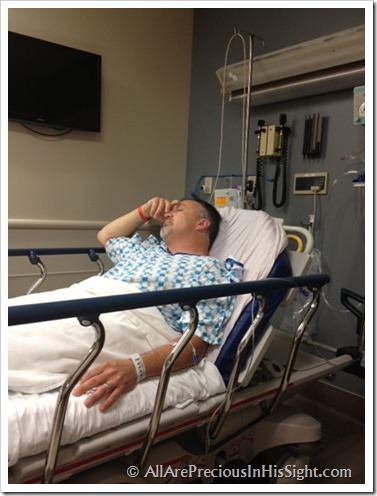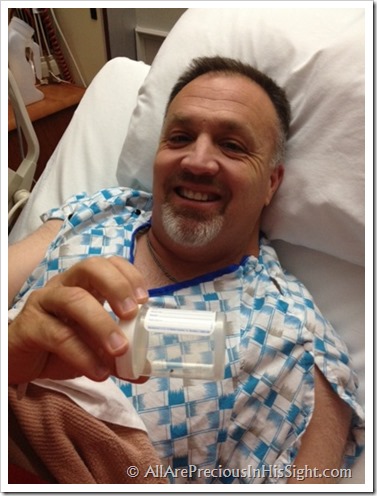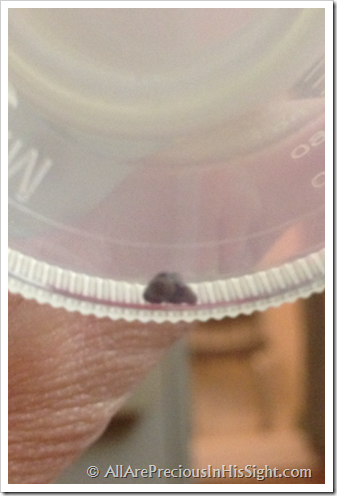“Wearing a linen ephod, David was dancing before the LORD with all his might…” 2 Samuel 6:14
I’ve studied the life of David a few times. I think if David were alive today, I would really like him. He seems like such a manly man, yet he had such a sensitive, compassionate spirit. Yes, he made a lot of mistakes and bad choices, but his heart was just precious. Perhaps that’s why God said David had a heart like His.
Often times when I’m absolutely giddy with excitement about something the Lord has done, I mentally picture David dancing in his ephod (a garment that I envision as somewhat similar to a loin cloth). I sometimes crack up about that mental picture because it just feels so real. Like when no one is in our home and we crank up the praise and worship music and dance and sing in the shower. That’s what I picture when I think of David dancing in his ephod.
So why am I talking about dancing in ephods? Well, read on to discover why this is on my mind.
I spent yesterday in the ER with my precious hubby. Bless his heart, he has had his share of illnesses and injuries. He’s the toughest man I know, with the most sensitive and compassionate heart of any man I’ve ever met. He reminds me of David (minus the bad choices David made!).
Matt has ulcerative colitis, which causes many other harmful disorders and symptoms. Kidney stones a side effect of ulcerative colitis. Matt has had three kidney stones in the last five years that have gotten lodged and caused pain levels like nothing else.
Just to give you an idea of Matt’s pain tolerance, back in 2005, he broke his back in 5 places when he was bucked off his horse and landed on a cedar stump. OUCH! He had internal bleeding and two hematomas the size of an IV bag of fluids! Even then, without any pain meds, Matt walked into the ER and his pain level was only a 4.
Well, Matt woke yesterday morning knowing he had a kidney stone that had escaped from his kidney and gotten lodged somewhere. He was MISERABLE with a pain level of 11-12 (on a scale of 1-10)! I drove him to the ER and contacted his urologist. I prayed over Matt, claiming healing and praying against the spirit of infirmity. Several friends were praying as well, but Matt wasn’t getting any pain relief or healing. I just knew Matt was going to need surgery. Sure enough, a CT scan confirmed a kidney stone was lodged in the narrow ureter, just before the bladder, and it was a large stone that wouldn’t be able to pass without surgery. (Matt had to have surgery three years ago for a different kidney stone that wouldn’t pass that was smaller than the one they found yesterday.)
Matt’s urologist confirmed he would need to surgically remove this kidney stone, and Matt agreed. Because Matt’s pain level was so unbelievably high, he was admitted to the hospital and given Dilaudid, a wonderful IV pain killer (an opioid narcotic), which was the only thing that even touched Matt’s pain. Matt was scheduled for surgery for 9:30AM the following morning because the OR was booked all day and night at the hospital, so he would have the first available slot, which wasn’t until the following morning.
Well, around 8:30PM Thursday, Matt was finally settled into his hospital room, exhausted and ready for bed. His pain was managed well with the use of Dilaudid via a PCA pump that enabled Matt to simply push a button to administer more pain meds via IV as needed. I decided I would go back home to the kids and sleep there, then return to the hospital this morning for his surgery. I asked Matt to go ahead and use the restroom before I left so I could help him with his IV pole and all of the tubing and cords, then get him tucked back into bed for the night.
We bobbled our way to the bathroom, trying not to have to unplug the equipment and make the IV pole reach far enough for Matt to stand at the toilet. (TMI, I know.) Well, here’s the best part of the story:
What to my wondering ears did I hear? Matt exclaiming, “I think I just passed it!!!!!” To which I replied, “Remember, the nurse said there might be particles in the filter, but not to be alarmed. I doubt it’s your stone, sweetheart.” (Oh, doubting Thomas, katisk, katisk.)
Then Matt handed me the urine filter, and I knew immediately that Matt was correct. He had passed the stone!!! The same stone that was so large and so lodged that it would indeed require surgery. We stared with disbelief at that painful, jagged stone we had prayed against.
Then…we danced in our ephods!!! (Not literally in ephods, but close because Matt’s hospital gown wasn’t covering his private area!) Oh my goodness, the shouts of praise coming from room 302 could probably be heard on every floor!
This meant Matt would NOT need surgery. HALLELUJAH!!! A Facebook friend had sent me a message just prior to this praying against this stone, praying for healing by the blood of Jesus, telling me she felt the healing was occurring right then. I brushed it off and explained how Matt would have to have surgery and we were OK with that. Nope, God had different plans. Pretty crazy!
Then a CNA (certified nursing assistant) came into the room, looked at the stone and said, “This little thing caused you that much pain?” WRONG thing to say, Miss I’ve Obviously Never Had a Kidney Stone. Wrong thing to say.
However, that didn’t put a damper on our praise party, although the CNA probably would have preferred to not view the ephod dancing. ![]()
We are seriously praising God for His healing!!! Thank you, Jesus!!!





 Kidney stones usually make their presence known suddenly, often sending a person to the hospital in excruciating pain. Each year in the U.S. more than a million people seek medical attention for kidney stones, technically called nephrolithiasis. The total annual cost of treatment exceeds $2.1 billion, according to the National Kidney and Urologic Diseases Information Clearinghouse.
Kidney stones usually make their presence known suddenly, often sending a person to the hospital in excruciating pain. Each year in the U.S. more than a million people seek medical attention for kidney stones, technically called nephrolithiasis. The total annual cost of treatment exceeds $2.1 billion, according to the National Kidney and Urologic Diseases Information Clearinghouse.